WiFi has become such a normal part of our lives that it is easy to forget how new it really is. Every time we stream a video, send a message, or connect a smart device, we rely on a technology that is less than three decades old in its mainstream form. Yet behind this convenience lies a long and fascinating story. The history of WiFi technology and inventors stretches back more than a century, connecting some of the most brilliant scientific minds with modern engineers who made wireless internet possible.
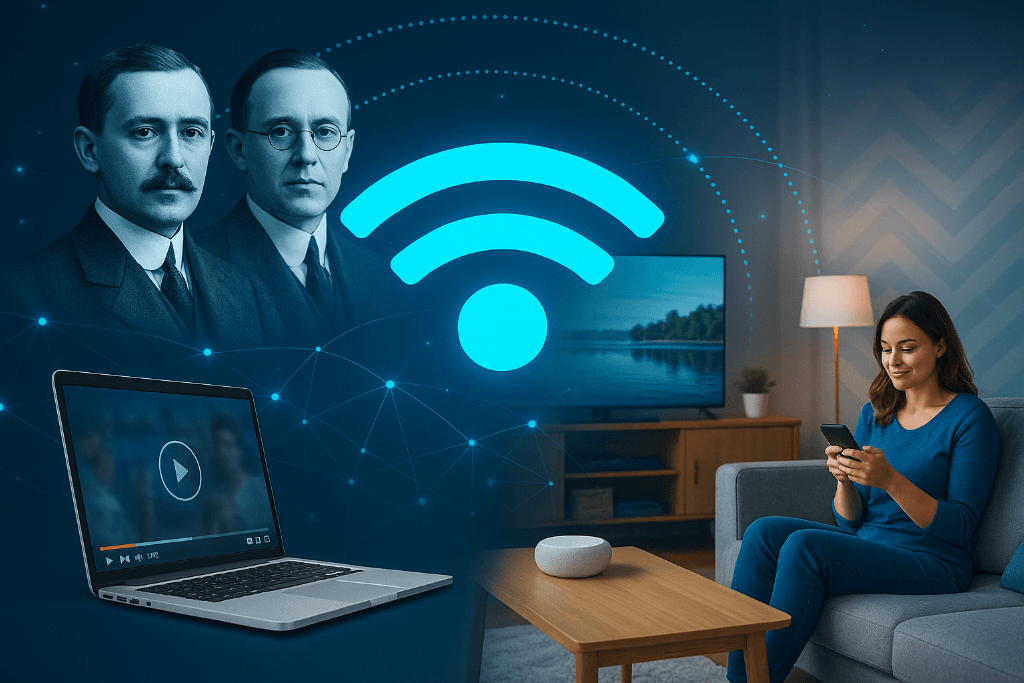
This article takes you on a journey from the first theories of electromagnetic waves to the creation of international WiFi standards. Along the way, you’ll meet inventors like Nikola Tesla, Guglielmo Marconi, Hedy Lamarr, Vic Hayes, and John O’Sullivan. You’ll also see how corporations, patent battles, and global collaboration shaped the networks we depend on today.
By the end, you’ll understand that WiFi was not a single invention from a single person. Instead, it was the result of many contributions, spanning physics, radio technology, computer networking, and standardization. Each step built upon the last, and together they created the wireless world we now live in.
The Roots Of Wireless Communication
The roots of wireless communication trace back to the late 19th century, when scientists first uncovered the invisible forces that would later carry voices, signals, and eventually data across the world. James Clerk Maxwell’s electromagnetic theory in the 1860s provided the foundation, proving mathematically that electric and magnetic fields could travel as waves through space. A few decades later, Heinrich Hertz confirmed Maxwell’s predictions by generating and detecting radio waves in his laboratory, showing that wireless energy was not just theory but reality. These discoveries opened the door for visionaries like Nikola Tesla, who imagined transmitting information and power without wires, and Guglielmo Marconi, who brought radio telegraphy into practical use. Together, their breakthroughs transformed wireless communication from abstract science into a technology with real-world applications, laying the groundwork for the inventions that would eventually evolve into WiFi.
Early Theories Of Electromagnetic Waves
In the mid-19th century, Scottish physicist James Clerk Maxwell proposed a groundbreaking theory. His equations described how electric and magnetic fields travel through space as waves. These ideas, published in the 1860s, laid the theoretical foundation for all wireless communication.
In the 1880s, German physicist Heinrich Hertz demonstrated that electromagnetic waves could be generated and detected. Using spark-gap transmitters and receivers, Hertz showed that radio waves existed, behaving exactly as Maxwell had predicted. His experiments were small in scale, but they proved that invisible energy could travel wirelessly through the air.
Without Maxwell’s vision and Hertz’s proof, the possibility of sending information without wires might have remained a dream. Their work set the stage for inventors who would soon harness these invisible waves.
Nikola Tesla And Wireless Transmission
Nikola Tesla is often remembered for his experiments with alternating current, but he also explored wireless communication. In the 1890s, Tesla experimented with high-frequency currents and resonant circuits, envisioning a world where information and even energy could be transmitted through the air.
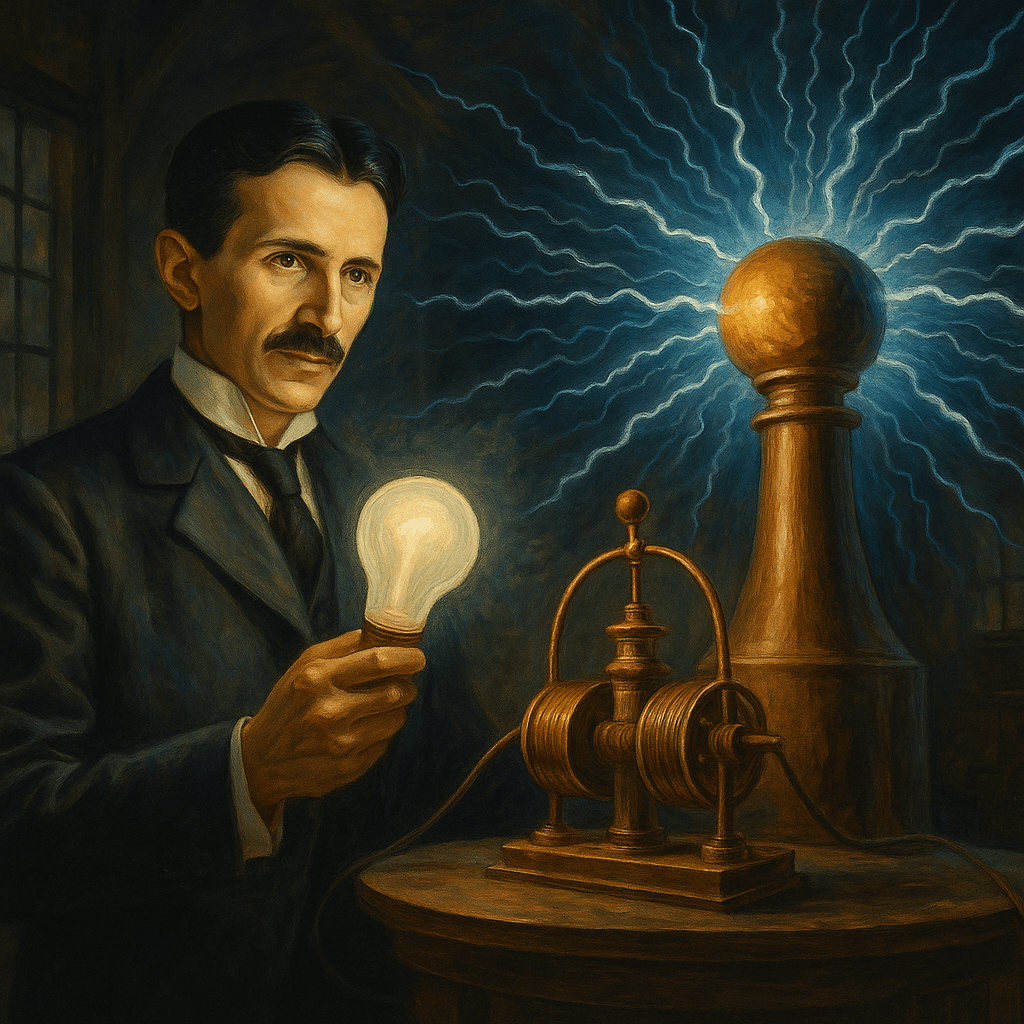
Tesla demonstrated wireless lamps, experimented with radio signals, and secured patents for wireless transmission. Although his grand plans for a global wireless energy system never materialized, his research directly influenced later inventors. Some even argue that Tesla foresaw technologies resembling WiFi.
While Tesla did not invent WiFi, his pioneering experiments in wireless transmission expanded the boundaries of what was possible and inspired a generation of scientists to explore new frontiers.
Guglielmo Marconi And Radio Telegraphy
Italian inventor Guglielmo Marconi turned theory into practical technology. In the late 1890s, he developed the first radio telegraphy systems, sending Morse code wirelessly over long distances. By 1901, he had achieved transatlantic radio communication an incredible leap at the time.
Marconi’s systems used relatively simple transmitters and receivers, but they proved that wireless signals could connect continents. His success gave birth to commercial and military radio industries, setting the groundwork for all future wireless communication.
Although Marconi’s focus was on telegraphy, not digital data, his achievements showed that invisible radio waves could reliably carry information. In many ways, his work was the bridge between Hertz’s experiments and the development of technologies that would eventually lead to WiFi.
Foundations Leading Toward WiFi
The foundations leading toward WiFi were laid across the 20th century as wireless technology evolved beyond simple radio communication. During World War II, innovators like Hedy Lamarr and George Antheil introduced the concept of frequency-hopping spread spectrum, a method designed to secure military transmissions but later essential for preventing interference in modern wireless networks. At the same time, advances in radar and microwave technology deepened scientific understanding of high-frequency signals, paving the way for their civilian use. By the 1970s, researchers were already experimenting with wireless computer networks, most notably the University of Hawaii’s ALOHAnet, which pioneered concepts like packet switching and retransmission. These stepping stones, secure transmission methods, microwave communication, and early wireless networking experiments came together to form the technical and conceptual groundwork for WiFi as we know it today.
Spread Spectrum And Secure Wireless Ideas
During World War II, a surprising contribution to wireless technology came from Hollywood actress Hedy Lamarr and composer George Antheil. In 1941, they patented a “frequency-hopping” system that allowed secure, interference-resistant communication by rapidly switching between frequencies.
Although their idea was initially overlooked, it later became foundational for spread spectrum technology. This principle is vital for modern WiFi because it allows multiple devices to share the same frequencies without interfering with one another.
Lamarr and Antheil’s innovation showed that progress often comes from unexpected places. Their work was decades ahead of its time but would later prove essential for reliable wireless networking.
Radar And Microwave Developments In WWII
The Second World War accelerated innovation in radar and microwave communication. Military engineers developed systems capable of detecting aircraft and guiding weapons using high-frequency signals. These advances improved understanding of how to send and receive signals at different wavelengths.
After the war, researchers adapted these technologies for civilian applications. Microwave links became important for long-distance telecommunication, television broadcasting, and early experiments in data transmission.
These wartime breakthroughs provided technical knowledge that engineers later used in WiFi development. Without radar and microwave research, reliable short-range wireless data communication might have been impossible.
From Radio To Computer Networking
By the mid-20th century, radio was well established. The next challenge was connecting computers. In the 1960s and 1970s, ARPANET experiments showed that digital networks could link machines across long distances. However, most of these connections required wires.
Researchers began testing wireless methods to connect computers. The University of Hawaii developed ALOHA net in 1971, one of the first wireless packet-switching networks. Though primitive by today’s standards, it introduced concepts like collision detection and data retransmission that remain crucial in WiFi.
This period marked a transition: wireless communication was no longer just for voice and telegraphy. It was becoming a way to connect computers an essential step toward modern WiFi networks.
The Birth Of WiFi Standards
The birth of WiFi standards began in the late 1980s and early 1990s, when companies and researchers were experimenting with different forms of wireless local area networks (LANs). While promising, these early systems often failed to work together because each company used its own protocols. To solve this problem, the Institute of Electrical and Electronics Engineers (IEEE) created the 802.11 working group in 1990. Under the guidance of Vic Hayes, later known as the “Father of WiFi,” the committee brought together industry rivals to establish a common framework for wireless networking. Their efforts culminated in the release of the first IEEE 802.11 standard in 1997, which allowed devices to exchange data at up to 2 Mbps. Though modest by modern standards, this breakthrough laid the foundation for global interoperability, making it possible for laptops, routers, and eventually smartphones to connect seamlessly across networks.
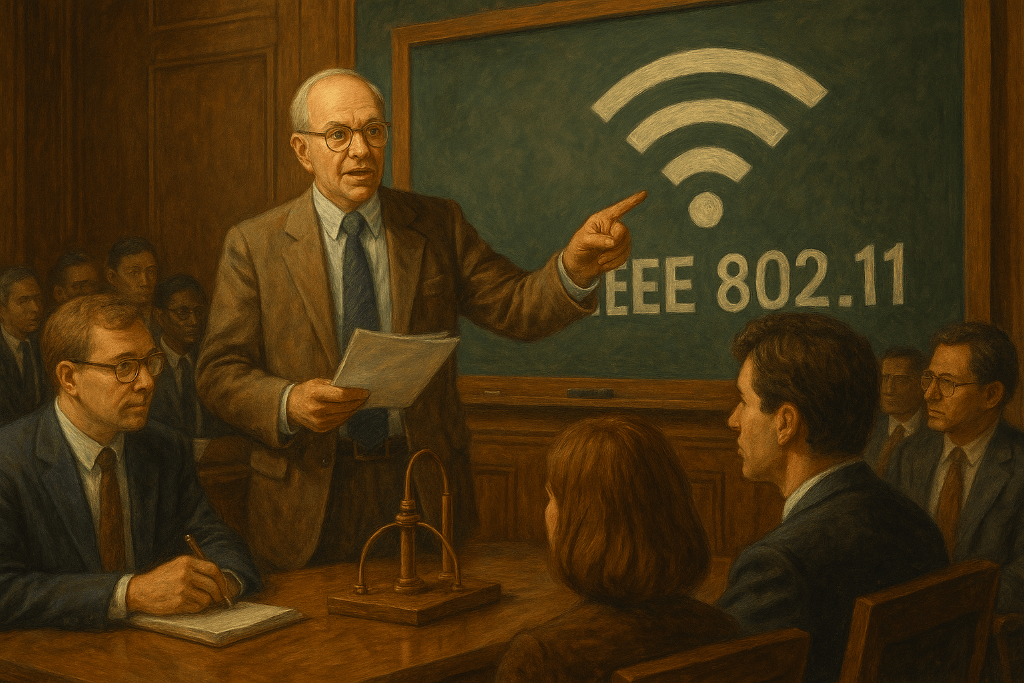
The Rise Of IEEE And 802.11 Working Group
By the 1980s, many companies were experimenting with wireless LANs. However, without a common standard, devices from different manufacturers could not communicate. This fragmentation limited adoption.
In 1990, the Institute of Electrical and Electronics Engineers (IEEE) formed the 802.11 working group to solve the problem. Their goal was to create universal rules for wireless networking, ensuring compatibility across devices.
The group’s work marked a turning point. By creating a shared technical language, they enabled the growth of a global WiFi ecosystem. This effort laid the foundation for WiFi’s explosive adoption in the years to come.
Vic Hayes: The “Father Of WiFi”
At the center of the IEEE 802.11 effort was Vic Hayes, often called the “Father of WiFi.” As the chair of the committee, Hayes guided the development of the first WiFi standards. His leadership ensured that competing companies and researchers worked together instead of against one another.
Hayes did not invent WiFi hardware, but his role in standardization was just as crucial. By establishing interoperability, he made it possible for laptops, routers, and smartphones to use the same wireless networks worldwide.
Without Hayes and the 802.11 committee, WiFi might have remained a patchwork of incompatible systems. Instead, it became a truly global technology.
The First 802.11 Protocol (1997)
In 1997, the IEEE released the first official 802.11 standard. It allowed wireless data transfer at speeds of up to 2 Mbps slow compared to today, but revolutionary at the time.
The protocol defined how devices would connect, communicate, and secure data over wireless signals. Although limited in range and speed, it provided the framework that future versions of WiFi would expand upon.
The release of 802.11 was not the end of development, but the beginning. It opened the door for innovation and set the stage for WiFi’s rapid improvement in the following decades.
Inventors And Companies That Shaped WiFi
The story of WiFi’s development is not tied to a single inventor but to a network of scientists, engineers, and companies whose combined efforts made wireless internet possible. In the 1990s, John O’Sullivan and his team at Australia’s CSIRO adapted radio-astronomy techniques to solve the problem of signal interference, creating the foundation for reliable WiFi connections. At the same time, companies like NCR Corporation and AT&T were developing WaveLAN, an early wireless LAN product that proved the practicality of cable-free networking in commercial environments. Other contributors, such as Bruce Tuch, who advanced wireless chipsets, and Phil Belanger, who helped establish the Wi-Fi Alliance and even coined the name “WiFi,” ensured that the technology was both technically robust and widely recognizable. By blending scientific breakthroughs with corporate innovation and effective branding, these inventors and organizations transformed WiFi from a niche experiment into a universal technology used in nearly every corner of the world.
John O’Sullivan And CSIRO Team (Australia)
In the 1990s, Australian scientist John O’Sullivan and his team at the Commonwealth Scientific and Industrial Research Organisation (CSIRO) made a breakthrough. Originally researching black holes, they developed techniques to reduce signal interference. These methods proved ideal for wireless networking.
Their work allowed WiFi to function in everyday environments filled with reflections and obstacles. Without it, WiFi would have been far less reliable. CSIRO patented their technology, leading to a series of lawsuits against major tech companies. Eventually, they won billions in settlements, cementing their role in WiFi’s history.
O’Sullivan’s contribution shows how scientific curiosity in this case, astronomy can lead to unexpected innovations with enormous global impact.
NCR Corporation And AT&T (WaveLAN)
In the late 1980s, NCR Corporation and AT&T developed WaveLAN, one of the earliest commercial wireless LAN products. Designed for use in retail environments, WaveLAN allowed cash registers and other systems to connect without wires.
Though limited in speed, WaveLAN demonstrated the potential of wireless networking in business settings. It influenced the design of later WiFi systems and provided valuable experience for engineers who contributed to standardization.
WaveLAN may not be remembered by most consumers, but it was a critical step on the road to WiFi.
Other Key Contributors
Several other individuals and groups played important roles. Bruce Tuch developed early wireless chipsets that improved performance. Phil Belanger, one of the original 802.11 pioneers, coined the term “WiFi” and helped form the WiFi Alliance, an organization that promotes interoperability and branding.
Companies like Lucent, Symbol Technologies, and others also contributed technical innovations. Each improvement, from better antennas to more efficient chips, made WiFi more practical and affordable.
Together, these inventors and organizations transformed WiFi from a niche experiment into a household name.
The Evolution Of WiFi Generations
The evolution of WiFi generations reflects a steady march toward faster, more reliable, and more efficient wireless communication. The first generation, introduced in the late 1990s, brought modest speeds but proved the concept of wireless internet for homes and businesses. By the early 2000s, WiFi 2 and 3 delivered significant performance upgrades, enabling streaming, online gaming, and the spread of mobile computing. Later generations of WiFi 4, 5, and 6 introduced gigabit speeds, improved range, and the ability to support many devices simultaneously, meeting the needs of increasingly connected households and workplaces. Today, WiFi 6E expands into new frequency bands, and the arrival of WiFi 7 promises multi-gigabit speeds with ultra-low latency, paving the way for applications like virtual reality, cloud gaming, and smart cities. Each new generation has not only boosted performance but also expanded what is possible in everyday life, making WiFi an ever-evolving backbone of digital society.
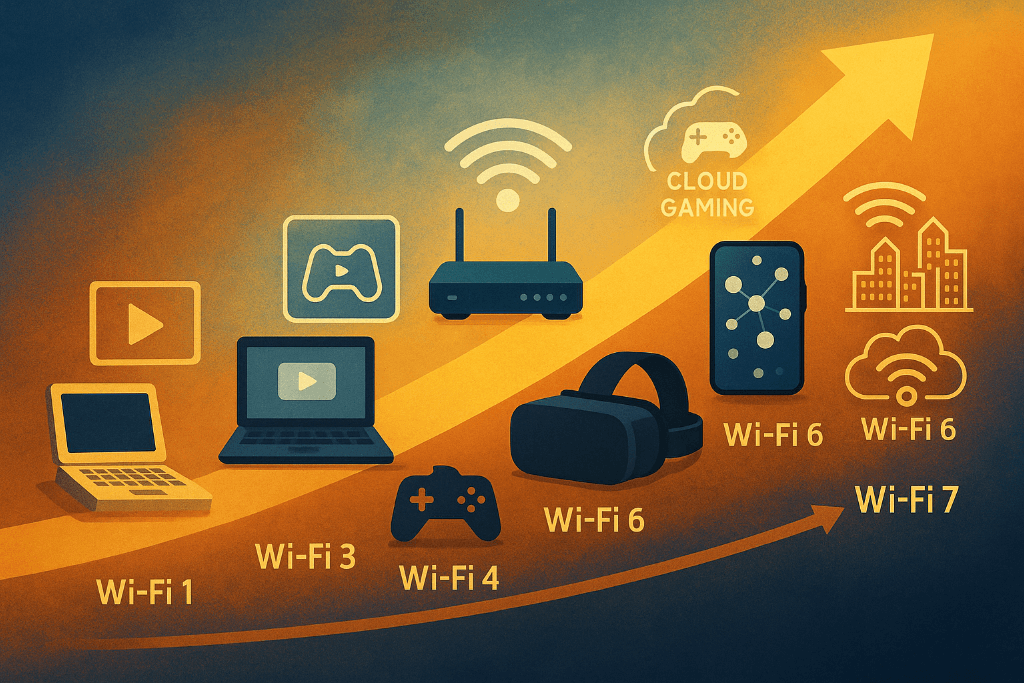
WiFi 1 (802.11a/b) – Late 1990s
The first generation of WiFi, known as 802.11a and 802.11b, appeared in the late 1990s. 802.11a offered speeds up to 54 Mbps but used the 5 GHz frequency band, which had shorter range and higher costs. 802.11b, although slower at 11 Mbps, worked on the 2.4 GHz band, offering better range and affordability.
802.11b, in particular, drove early adoption. Businesses, universities, and eventually households began installing wireless routers. Suddenly, laptops could connect to the internet without cables, marking the first major step in WiFi’s mainstream success.
These early standards may seem slow today, but they represented a revolution in convenience and connectivity.
WiFi 2 & 3 (802.11g/n) – 2000s
The 2000s brought new generations that pushed WiFi into everyday life. 802.11g, released in 2003, reached speeds of 54 Mbps on the 2.4 GHz band, combining speed with affordability. Its backward compatibility with 802.11b made it easy for consumers to upgrade without replacing all devices.
Later, 802.11n, released in 2009, revolutionized performance by introducing MIMO (Multiple Input, Multiple Output) technology. With multiple antennas, WiFi signals became stronger, faster, and more reliable. Speeds reached up to 600 Mbps, fueling the rise of streaming, online gaming, and cloud computing.
WiFi was no longer a luxury it had become a necessity for modern life.
WiFi 4, 5, 6, And Beyond
Subsequent standards WiFi 4 (802.11n), WiFi 5 (802.11ac), and WiFi 6 (802.11ax) continued the march toward faster, more efficient connectivity.
WiFi 5 introduced gigabit speeds, supporting HD streaming and the growing number of mobile devices. WiFi 6, launched in 2019, improved efficiency with technologies like OFDMA and MU-MIMO, allowing multiple devices to share bandwidth without slowdown.
Now, WiFi 6E extends into the 6 GHz band, offering uncluttered spectrum, while WiFi 7 promises multi-gigabit speeds and ultra-low latency. These advances ensure WiFi remains vital in a world filled with smart devices, IoT systems, and immersive media.
Global Impact Of WiFi
The global impact of WiFi has been nothing short of transformative, reshaping how people live, work, and communicate. What began as a way to connect computers without cables has grown into a technology that powers homes, businesses, schools, and public spaces across the world. WiFi made remote work and online education possible, fueled the rise of streaming platforms, and created the backbone for the Internet of Things, where billions of devices from smart appliances to wearable health trackers communicate seamlessly. In developing regions, WiFi has helped bridge the digital divide by providing affordable internet access in places where wired infrastructure is limited. It has also redefined social interaction, enabling instant messaging, video calls, and global collaboration in real time. More than just a convenience, WiFi has become a critical driver of economic growth, innovation, and connectivity, embedding itself as an invisible yet indispensable utility in modern society.
How WiFi Changed Everyday Life
WiFi transformed homes, workplaces, and public spaces. At home, it allowed families to connect multiple devices without cluttered wires. In cafes, airports, and hotels, WiFi hotspots created new expectations for mobility.
Beyond convenience, WiFi fueled new industries. Streaming services, remote work, online education, and cloud storage all rely on it. Many now consider WiFi a basic necessity, as essential as electricity or running water.
WiFi VS Cellular Networks
While WiFi and cellular networks both provide wireless connectivity, they serve different needs. WiFi delivers high speeds at low cost within limited ranges, making it ideal for homes, businesses, and public venues. Cellular networks cover wide areas and support mobility, but at higher cost.
Rather than competing, the two technologies complement each other. Smartphones, for example, seamlessly switch between WiFi and cellular networks, providing continuous connectivity.
WiFi As A Catalyst For Innovation
The rise of the Internet of Things (IoT) owes much to WiFi. From smart thermostats and appliances to wearable devices, WiFi connects billions of objects.
It has also enabled telemedicine, video conferencing, e-learning, and countless apps that shape daily life. WiFi remains the invisible backbone of the digital age.
Controversies, Patents, And Legal Battles
While WiFi is celebrated as a global success story, its development also sparked controversies, patent disputes, and legal battles that revealed the high stakes of technological innovation. One of the most notable cases involved Australia’s CSIRO, which held key patents on interference-reduction methods essential to WiFi. For years, tech giants like Microsoft, Dell, and Intel used these technologies without licensing them, prompting CSIRO to pursue lawsuits that eventually resulted in billions of dollars in settlements. Beyond patents, rival companies also clashed in the early days of WiFi over competing standards, threatening to fragment the market until the IEEE and Wi-Fi Alliance unified the industry. These disputes sparked debates over who should receive credit for WiFi’s invention, whether it was scientists like John O’Sullivan, engineers like Vic Hayes, or earlier visionaries such as Tesla and Marconi. In truth, the conflicts underscore that WiFi was never the product of a single mind, but rather the collective result of contributions made across decades, industries, and nations.
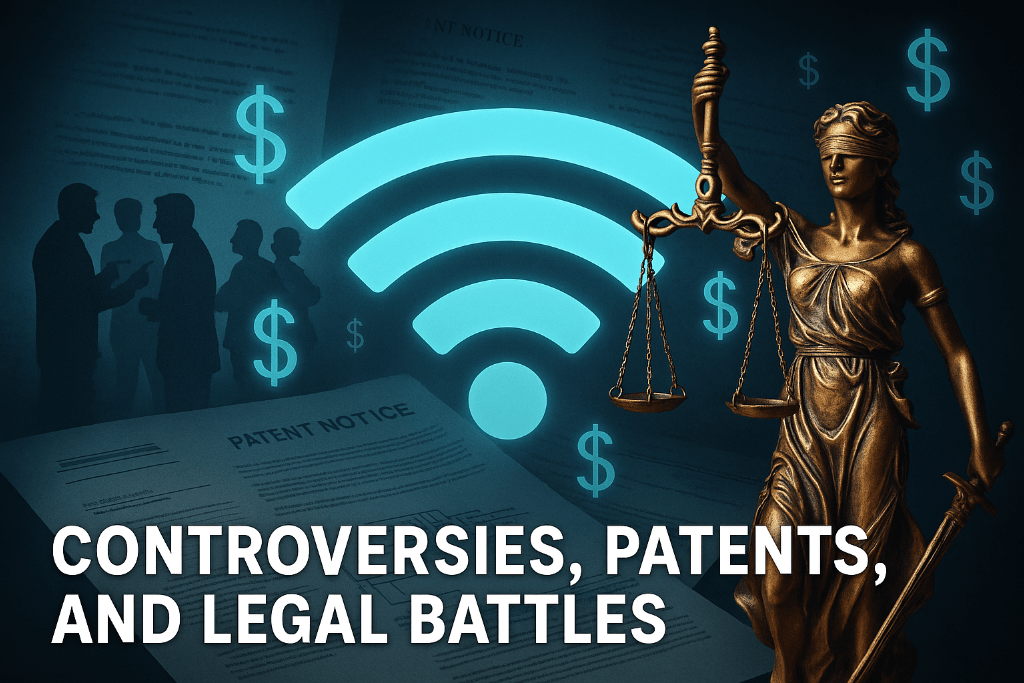
CSIRO’s Global WiFi Lawsuits
CSIRO’s patents on interference-reduction technology sparked global lawsuits. The organization claimed that companies like Microsoft, Dell, and Intel used their technology without licensing.
After years of legal battles, CSIRO won billions in settlements. These victories highlighted not only the importance of intellectual property in tech but also Australia’s overlooked role in WiFi’s creation.
Corporate Rivalries And Standardization
In WiFi’s early days, rival companies pushed competing technologies. Without agreement, the market risked fragmentation. The IEEE 802.11 committee and the WiFi Alliance resolved this by enforcing interoperability and branding. This unity transformed WiFi into a universal standard, ensuring its global dominance.
The Debate: Who Really Invented WiFi?
A common question is, “Who invented WiFi?” The truth is that WiFi has no single inventor. It is the culmination of contributions by Maxwell, Hertz, Tesla, Marconi, Lamarr, Hayes, O’Sullivan, and many others.
This collective effort makes the history of WiFi technology and inventors so fascinating: it was built piece by piece, across decades, by minds working toward a shared vision of wireless communication.
The Future Of WiFi Technology
The future of WiFi technology promises even greater speed, reliability, and integration with the digital world around us. Emerging standards like WiFi 7 are expected to deliver multi-gigabit connections with ultra-low latency, making advanced applications such as immersive virtual reality, cloud-based gaming, and 8K video streaming seamless. Beyond raw performance, WiFi will play a central role in powering the expanding Internet of Things (IoT), where smart homes, autonomous vehicles, and connected healthcare systems depend on instant, secure communication. Artificial intelligence is also set to optimize WiFi networks, automatically adjusting bandwidth and reducing interference for smoother experiences. Looking further ahead, researchers are exploring terahertz frequencies and even integrating WiFi with 5G and satellite systems, envisioning a world of ubiquitous wireless connectivity. These advancements show that while WiFi has already transformed society, its most revolutionary contributions may still be on the horizon.
WiFi 7 And Terahertz Communication
The next leap is WiFi 7, which will support multi-gigabit speeds, ultra-low latency, and applications like augmented reality, virtual reality, and 8K streaming. Beyond WiFi 7, researchers are exploring terahertz frequencies, which could enable even faster and more energy-efficient wireless communication.
Integration With AI And IoT
WiFi will increasingly integrate with artificial intelligence and IoT ecosystems. Smart homes, autonomous vehicles, and connected healthcare systems will rely on WiFi for reliability and speed. AI-driven networks will self-optimize, reduce interference, and improve security.
Beyond WiFi: The Vision Of Ubiquitous Wireless
Some experts envision WiFi merging with 5G, satellite networks, and even quantum communication. The goal is ubiquitous connectivity, where devices move between networks seamlessly, creating a truly global digital fabric.
Whatever shape the future takes, WiFi will remain central to innovation.

Final Thoughts
The story of WiFi is a story of collaboration across time, nations, and disciplines. From Maxwell’s equations to Hertz’s experiments, from Tesla’s wireless visions to Marconi’s radio, from Lamarr’s frequency-hopping patent to O’Sullivan’s interference solution each step added a piece of the puzzle.
Organizations like the IEEE and leaders like Vic Hayes transformed these discoveries into practical standards, while companies and engineers brought them to life in consumer devices. Legal battles and rivalries remind us that credit is rarely simple, but they also highlight the global effort behind WiFi.
Today, WiFi is more than just a technology it is part of our daily existence. And as it continues to evolve, it stands as proof that innovation is rarely the work of one person. Instead, it is a shared human achievement, built across generations.
FAQs
Who Is Considered The Father Of WiFi?
Vic Hayes, chair of the IEEE 802.11 committee, is often called the “Father of WiFi” because he guided the standardization process that made WiFi universal.
What Was The First WiFi Standard Released?
The first WiFi standard was IEEE 802.11, released in 1997. It offered speeds of up to 2 Mbps and established the foundation for modern wireless networking.
Did Nikola Tesla Really Invent WiFi?
Tesla did not invent WiFi, but his wireless energy and radio experiments in the 1890s inspired later advances in wireless communication.
How Did John O’Sullivan’s Work Contribute To WiFi?
O’Sullivan and his CSIRO team developed interference-reduction techniques that made WiFi reliable in real-world environments, leading to successful patents.
Why Did CSIRO Sue Major Tech Companies Over WiFi Patents?
CSIRO held patents on key WiFi technologies. When companies used these without licenses, CSIRO pursued lawsuits and ultimately won billions in settlements.
What’s The Difference Between WiFi 5 And WiFi 6?
WiFi 5 provided high speeds, while WiFi 6 improved efficiency, range, and the ability to handle many devices simultaneously with better stability.
What Does The Future Of WiFi Look Like?
WiFi 7 will deliver multi-gigabit speeds, ultra-low latency, and integration with AI and IoT. Looking further, WiFi may merge with 5G and satellite networks for seamless global coverage.
Also Read: Who Invented Mathematical Symbols?
